Selenium and Redox Enzyme Activity in Pregnant Women Exposed to Methylmercury
Abstract
:1. Introduction
2. Materials and Methods
2.1. Study Population Recruitment and Sample Collection
2.2. Reagents
2.3. Sample Pre-Treatment for Total Se Analysis
2.4. Selenium Quantification
2.5. Quality Control
2.6. Thioredoxin Reductase and Thioredoxin Activity in Plasma
2.7. Glutathione Peroxidase Activity in Plasma
2.8. Analysis of Total Hg in Blood Samples
2.9. Statistical Analysis
3. Results
3.1. Selenium Concentration in Whole Blood and Plasma
3.2. Redox Proteins Activity
4. Discussion
Author Contributions
Funding
Institutional Review Board Statement
Informed Consent Statement
Data Availability Statement
Acknowledgments
Conflicts of Interest
Appendix A
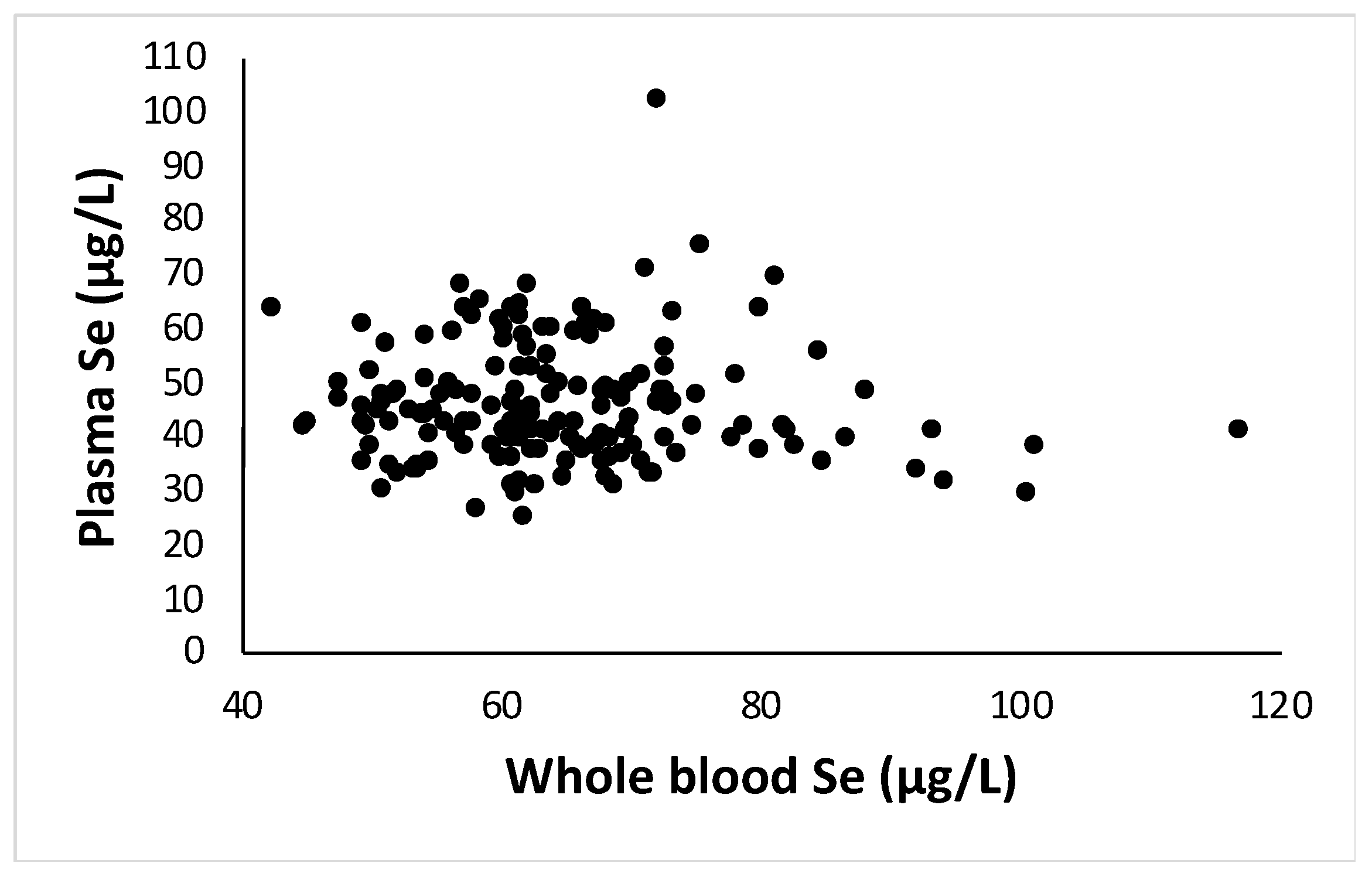

Appendix B
| Variables Entered/Removed a | |||||||
| Model | Variables Entered | Variables Removed | Method | ||||
| 1 | Hg (µg/L) WB b | Enter | |||||
| a. Dependent Variable: Trx (ng/mL) Plasma | |||||||
| b. All requested variables entered. | |||||||
| Model Summary | |||||||
| Model | R | R Square | Adjusted R Square | Std. Error of the Estimate | |||
| 1 | 0.096 a | 0.009 | 0.007 | 119.71437 | |||
| a. Predictors: (Constant), Hg (µg/L) WB | |||||||
| ANOVA a | |||||||
| Model | Sum of Squares | df | Mean Square | F | Sig. | ||
| 1 | Regression | 62822.470 | 1 | 62822.470 | 4.384 | 0.037 b | |
| Residual | 6721487.713 | 469 | 14331.530 | ||||
| Total | 6784310.183 | 470 | |||||
| a. Dependent Variable: Trx (ng/mL) Plasma | |||||||
| b. Predictors: (Constant), Hg (µg/L) WB | |||||||
| Coefficients a | |||||||
| Model | Unstandardized Coefficients | Standardized Coefficients | t | Sig. | |||
| B | Std. Error | Beta | |||||
| 1 | (Constant) | 251.551 | 9.196 | 27.353 | 0.000 | ||
| Hg (µg/L) WB | −1.733 | 0.828 | −0.096 | −2.094 | 0.037 | ||
| a. Dependent Variable: Trx (ng/mL) Plasma | |||||||
References
- Rayman, M.P. The importance of selenium to human health. Lancet 2000, 356, 233–241. [Google Scholar] [CrossRef] [Green Version]
- EFSA NDA Panel (EFSA Panel on Dietetic Products Nutrition and Allergies). Scientific Opinion on Dietary Reference Values for selenium. EFSA J. 2014, 12, 3846. [Google Scholar] [CrossRef]
- Kipp, A.P.; Strohm, D.; Brigelius-Flohé, R.; Schomburg, L.; Bechthold, A.; Leschik-Bonnet, E.; Heseker, H. Revised reference values for selenium intake. J. Trace Elem. Med. Biol. 2015, 32, 195–199. [Google Scholar] [CrossRef] [Green Version]
- Australian National Health and Medical Research Council (NHMRC). Nutrient Reference Values for Australia and New Zealand; National Health and Medical Research Council: Canberra, Australia, 2006. [Google Scholar]
- Levander, O.A.; Burk, R.F. Update of human dietary standards for selenium. In Selenium: Its Molecular Biology and Role in Human Health, 2nd ed.; Hatfield, D.L., Berry, M.J., Gladyshev, V.N., Eds.; Springer: Boston, MA, USA, 2006; pp. 399–410. ISBN 9780387338279. [Google Scholar]
- Reilly, C. Selenium in Food and Health, 2nd ed.; Springer: Berlin/Heidelberg, Germany, 2006; ISBN 038733243X. [Google Scholar]
- Joint FAO/WHO Expert Consultation on Human Vitamin and Mineral Requirements. In Vitamin and Mineral Requirements in Human Nutrition, 2nd ed.; World Health Organization: Geneva, Switzerland, 2004.
- Diplock, A.T. Indexes of selenium status in human populations. Am. J. Clin. Nutr. 1993, 57, 256S–258S. [Google Scholar] [CrossRef]
- Xia, Y.; Hill, K.E.; Burk, R.F. Biochemical Studies of a Selenium-Deficient Population in China: Measurement of Selenium, Glutathione Peroxidase and Other Oxidant Defense Indices in Blood. J. Nutr. 1989, 119, 1318–1326. [Google Scholar] [CrossRef]
- Chen, X.; Yang, G.; Chen, J.; Chen, X.; Wen, Z.; Ge, K. Studies on the relations of selenium and Keshan disease. Biol. Trace Elem. Res. 1980, 2, 91–107. [Google Scholar] [CrossRef] [PubMed]
- Bleys, J.; Navas-Acien, A.; Guallar, E. Serum Selenium Levels and All-Cause, Cancer, and Cardiovascular Mortality among US Adults. Arch. Intern. Med. 2008, 168, 404–410. [Google Scholar] [CrossRef] [PubMed] [Green Version]
- Akbaraly, N.T.; Arnaud, J.; Hininger-Favier, I.; Gourlet, V.; Roussel, A.-M.; Berr, C. Selenium and Mortality in the Elderly: Results from the EVA Study. Clin. Chem. 2005, 51, 2117–2123. [Google Scholar] [CrossRef] [PubMed] [Green Version]
- Benton, D.; Cook, R. Selenium supplementation improves mood in a double-blind crossover trial. Psychopharmacology 1990, 102, 549–550. [Google Scholar] [CrossRef] [PubMed]
- Hoffmann, P.R. Mechanisms by which selenium influences immune responses. Arch. Immunol. Ther. Exp. 2007, 55, 289. [Google Scholar] [CrossRef] [PubMed]
- Pillai, R.; Uyehara-Lock, J.H.; Bellinger, F.P. Selenium and selenoprotein function in brain disorders. IUBMB Life 2014, 66, 229–239. [Google Scholar] [CrossRef] [PubMed]
- Schomburg, L.; Köhrle, J. On the importance of selenium and iodine metabolism for thyroid hormone biosynthesis and human health. Mol. Nutr. Food Res. 2008, 52, 1235–1246. [Google Scholar] [CrossRef] [PubMed]
- Garolla, A.; Foresta, C.; Flohé, L.; Roveri, A.; Ursini, F.; Maiorino, M. Male Fertility Is Linked to the Selenoprotein Phospholipid Hydroperoxide Glutathione Peroxidase. Biol. Reprod. 2002, 67, 967–971. [Google Scholar]
- Vinceti, M.; Filippini, T.; Cilloni, S.; Crespi, C.M. The Epidemiology of Selenium and Human Cancer. Adv. Cancer Res. 2017, 136, 1–48. [Google Scholar]
- Rees, K.; Hartley, L.; Day, C.; Flowers, N.; Clarke, A.; Stranges, S. Selenium supplementation for the primary prevention of cardiovascular disease. Cochrane Database Syst. Rev. 2013, 2013, CD009671. [Google Scholar] [CrossRef] [Green Version]
- Brigo, F.; Storti, M.; Lochner, P.; Tezzon, F.; Nardone, R. Selenium supplementation for primary prevention of cardiovascular disease: Proof of no effectiveness. Nutr. Metab. Cardiovasc. Dis. 2014, 24, e2–e3. [Google Scholar] [CrossRef]
- Lippman, S.M.; Klein, E.A.; Goodman, P.J.; Lucia, M.S.; Thompson, M.; Ford, L.G.; Parnes, H.L.; Minasian, L.M.; Gaziano, M.; Hartline, J.A.; et al. Effect of Selenium and Vitamin E on Risk of Prostate Cancer and Other Cancers: The Selenium and Vitamin E Cancer Prevention Trial (SELECT). JAMA 2009, 301, 39–51. [Google Scholar] [CrossRef] [PubMed] [Green Version]
- Branco, V.; Carvalho, C. The thioredoxin system as a target for mercury compounds. BBA Gen. Subj. 2019, 1863, 129255. [Google Scholar] [CrossRef] [PubMed]
- Ralston, N.V.C. Selenium Health Benefit Values as Seafood Safety Criteria. Ecohealth 2008, 5, 442–455. [Google Scholar] [CrossRef] [PubMed]
- Gladyshev, V.N.; Arnér, E.S.; Berry, M.J.; Brigelius-Flohé, R.; Bruford, E.A.; Burk, R.F.; Carlson, B.A.; Castellano, S.; Chavatte, L.; Conrad, M.; et al. Selenoprotein Gene Nomenclature. J. Biol. Chem. 2016, 291, 24036–24040. [Google Scholar] [CrossRef] [Green Version]
- Papp, L.V.; Lu, J.; Holmgren, A.; Khanna, K.K. From selenium to selenoproteins: Synthesis, identity, and their role in human health. Antioxid. Redox Signal. 2007, 9, 775–806. [Google Scholar] [CrossRef] [PubMed] [Green Version]
- Kryukov, G.V.; Castellano, S.; Novoselov, S.V.; Lobanov, A.V.; Zehtab, O.; Guigó, R.; Gladyshev, V.N. Characterization of Mammalian Selenoproteomes. Science 2003, 300, 1439–1443. [Google Scholar] [CrossRef] [PubMed]
- Rayman, M.P. Selenium and human health. Lancet 2012, 379, 1256–1268. [Google Scholar] [CrossRef]
- Ralston, N.V.C.; Ralston, C.R.; Blackwell, J.L.; Raymond, L.J. Dietary and tissue selenium in relation to methylmercury toxicity. Neurotoxicology 2008, 29, 802–811. [Google Scholar] [CrossRef] [Green Version]
- Holmgren, A. Thioredoxin and glutaredoxin systems. J. Biol. Chem. 1989, 264, 13963–13966. [Google Scholar] [CrossRef]
- Zhong, L.; Arnér, E.S.; Holmgren, A. Structure and mechanism of mammalian thioredoxin reductase: The active site is a redox-active selenolthiol/selenenylsulfide formed from the conserved cysteine-selenocysteine sequence. Proc. Natl. Acad. Sci. USA 2000, 97, 5854–5859. [Google Scholar] [CrossRef] [PubMed] [Green Version]
- Brigelius-Flohé, R.; Maiorino, M. Glutathione Peroxidases. Biochim. Biophys. Acta 2017, 1830, 3289–3303. [Google Scholar] [CrossRef] [PubMed]
- Aro, A.; Alfthan, G.; Arvilommi, H.; Huttunen, J.K. Selenium metabolism and platelet glutathione peroxidase activity in healthy Finnish men: Effects of selenium yeast, selenite, and selenate. Am. J. Clin. Nutr. 1991, 53, 120–125. [Google Scholar]
- Duffield, A.J.; Hill, K.E.; Williams, S.; Thomson, C.D. An estimation of selenium requirements for New Zealanders. Am. J. Clin. Nutr. 1999, 70, 896–903. [Google Scholar] [CrossRef] [Green Version]
- Ralston, N.V.C.; Raymond, L.J. Dietary selenium’s protective effects against methylmercury toxicity. Toxicology 2010, 278, 112–123. [Google Scholar] [CrossRef]
- Li, Y.; He, B.; Nong, Q.; Qu, G.; Liu, L.; Shi, J.; Hu, L.; Jiang, G. Characterization of mercury-binding proteins in rat blood plasma. Chem. Commun. 2018, 54, 7439–7442. [Google Scholar] [CrossRef] [Green Version]
- Liu, Y.; Zhang, W.; Zhao, J.; Lin, X.; Liu, J.; Cui, L.; Gao, Y.; Zhang, T.-L.; Li, B.; Li, Y.-F. Selenoprotein P as the major transporter for mercury in serum from methylmercury-poisoned rats. J. Trace Elem. Med. Biol. 2018, 50, 589–595. [Google Scholar] [CrossRef] [PubMed]
- Branco, V.; Canário, J.; Holmgren, A.; Carvalho, C. Inhibition of the thioredoxin system in the brain and liver of zebra-seabreams exposed to waterborne methylmercury. Toxicol. Appl. Pharmacol. 2011, 251, 95–103. [Google Scholar] [CrossRef] [PubMed]
- Branco, V.; Canário, J.; Lu, J.; Holmgren, A.; Carvalho, C. Mercury and selenium interaction in vivo: Effects on thioredoxin reductase and glutathione peroxidase. Free. Radic. Biol. Med. 2012, 52, 781–793. [Google Scholar] [CrossRef] [PubMed]
- Branco, V.; Ramos, P.; Canário, J.; Lu, J.; Holmgren, A.; Carvalho, C. Biomarkers of adverse response to mercury: Histopathology versus thioredoxin reductase activity. J. Biomed. Biotechnol. 2012, 2012, 359879. [Google Scholar] [CrossRef]
- Carvalho, C.M.L.; Chew, E.H.; Hashemy, S.I.; Lu, J.; Holmgren, A. Inhibition of the human thioredoxin system: A molecular mechanism of mercury toxicity. J. Biol. Chem. 2008, 283, 11913–11923. [Google Scholar] [CrossRef] [PubMed] [Green Version]
- Carvalho, C.M.L.; Lu, J.; Zhang, X.; Arnér, E.S.J.; Holmgren, A. Effects of selenite and chelating agents on mammalian thioredoxin reductase inhibited by mercury: Implications for treatment of mercury poisoning. FASEB J. 2011, 25, 370–381. [Google Scholar] [CrossRef] [Green Version]
- Wagner, C.; Sudati, J.H.; Nogueira, C.W.; Rocha, J.B.T. In vivo and in vitro inhibition of mice thioredoxin reductase by methylmercury. BioMetals 2010, 23, 1171–1177. [Google Scholar] [CrossRef] [PubMed]
- Akahoshi, N.; Anan, Y.; Hashimoto, Y.; Tokoro, N.; Mizuno, R.; Hayashi, S.; Yamamoto, S.; Shimada, K.I.; Kamata, S.; Ishii, I. Dietary selenium deficiency or selenomethionine excess drastically alters organ selenium contents without altering the expression of most selenoproteins in mice. J. Nutr. Biochem. 2019, 69, 120–129. [Google Scholar] [CrossRef]
- Geillinger, K.E.; Rathmann, D.; Köhrle, J.; Fiamoncini, J.; Daniel, H.; Kipp, A.P. Hepatic metabolite profiles in mice with a suboptimal selenium status. J. Nutr. Biochem. 2014, 25, 914–922. [Google Scholar] [CrossRef] [PubMed]
- Xie, Z.; Sun, J.; Li, H.; Shao, T.; Wang, D.; Zheng, Q.; Wen, C. Plasma and Synovial Fluid TrxR Levels are Correlated with Disease Risk and Severity in Patients with Rheumatoid Arthritis. Medicine 2016, 95, e2543. [Google Scholar] [CrossRef] [PubMed]
- Ozturk, Z.; Genc, G.E.; Kupesiz, A.; Kurtoglu, E.; Gumuslu, S. Thalassemia major patients using iron chelators showed a reduced plasma thioredoxin level and reduced thioredoxin reductase activity, despite elevated oxidative stress. Free. Radic. Biol. Med. 2015, 49, 309–316. [Google Scholar] [CrossRef] [PubMed]
- Ye, S.; Chen, X.; Yao, Y.; Li, Y.; Sun, R.; Zeng, H.; Shu, Y.; Yin, H. Thioredoxin Reductase as a Novel and Efficient Plasma Biomarker for the Detection of Non-Small Cell Lung Cancer: A Large-scale, Multicenter study. Sci. Rep. 2019, 9, 2652. [Google Scholar] [CrossRef] [PubMed]
- Recommended Analytical Conditions and General Information for Flow Injection Mercury/Hydride Analyses Using the PerkinElmer FIAS-100/400; Perkin-Elmer: Waltham, MA, USA, 2004.
- Arnér, E.S.; Holmgren, A. Measurement of thioredoxin and thioredoxin reductase. In Current Protocols in Toxicology/Editorial Board, Mahin D. Maines (Editor-in-Chief)... [et al.]; John Wiley & Sons Inc.: Hoboken, NJ, USA, 2001; Volume 7, p. 7.4. [Google Scholar]
- Esworthy, R.S.; Chu, F.F.; Doroshow, J.H. Analysis of glutathione-related enzymes. In Current Protocols in Toxicology; Costa, L.G., Hodgson, E., Lawrence, D.A., Reed, D.J., GreenLee, W., Eds.; John Wiley & Sons Inc.: Hoboken, NJ, USA, 2001; pp. 7.1.1–7.1.32. [Google Scholar]
- Caetano, T.; Branco, V.; Cavaco, A.; Carvalho, C. Risk assessment of methylmercury in pregnant women and newborns in the island of Madeira (Portugal) using exposure biomarkers and food-frequency questionnaires. J. Toxicol. Environ. Health Part A 2019, 82, 833–844. [Google Scholar] [CrossRef] [PubMed]
- Magalhães, E.; Pereira, J. Serum levels of selenium in the Portuguese population—The highest in Europe. Acta Med. Port. 1986, 7, 119–120. [Google Scholar] [PubMed]
- Lopes, P.A.; Santos, M.C.; Vicente, L.; Rodrigues, M.O.; Pavao, M.L.; Nève, J.; Viegas-Crespo, A.M. Trace element status (Se, Cu, Zn) in healthy portuguese subjects of Lisbon population. Biol. Trace Elem. Res. 2004, 101, 1–17. [Google Scholar] [CrossRef] [Green Version]
- Pavão, M.L.; Santos, V.; Costa, A.; Borges, G.; Santos, M.C.; Nève, J.; Viegas-Crespo, A.M. Selenium, Copper, and Zinc in some azorean populations. In Proceedings of the New Aspects of Trace Element Rsearch—Vth Confrence of The International Society for Trace Elements Research in Humans, Lyon, France, 26-30thSeptember 1998; Abdulla, M., Bost, M., Gamon, S., Arnaud, P., Chazot, G., Eds.; Smith-Gordon: London, UK, 1999. [Google Scholar]
- Viegas-Crespo, A.M.; Pavão, M.L.; Santos, V.; Cruz, M.L.; Paulo, O.; Leal, J.; Sarmento, N.; Monteiro, M.L.; Amorim, M.F.; Halpern, M.J.; et al. Selenium status and cardiovascular risk factors in populations from different portuguese regions. In Natural Antioxidants and Food Quality in Atherosclerosis and Cancer Prevention; Kumpulainen, J., Salonen, J., Eds.; The Royal Society of Chemistry: London, UK, 1996; pp. 188–194. [Google Scholar]
- Gudmundsdottir, E.Y.; Gunnarsdottir, I.; Thorlacius, A.; Reykdal, O.; Gunnlaugsdottir, H.; Thorsdottir, I.; Steingrimsdottir, L. Blood selenium levels and contribution of food groups to selenium intake in adolescent girls in Iceland. Food Nutr. Res. 2012, 56, 18476. [Google Scholar] [CrossRef] [PubMed] [Green Version]
- Pavão, M.L.; Cordeiro, C.; Costa, A.; Raposo, J.A.; Santos, M.C.; Nève, J.; Viegas-Crespo, A.M. Comparison of whole-blood glutathione peroxidase activity, levels of serum selenium, and lipid peroxidation in subjects from the fishing and rural communities of Rabo de Peixe’ village, São Miguel Island, the Azores’ Archipelago, Portugal. Biol. Trace Elem. Res. 2003, 92, 27–40. [Google Scholar] [CrossRef] [Green Version]
- Viegas-Crespo, A.M.; Pavão, M.L.; Paulo, O.; Santos, V.; Santos, M.C.; Nève, J. Trace element status (Se, Cu, Zn) and serum lipid profile in Portuguese subjects of San Miguel Island from Azores’archipelago. J. Trace Elem. Med. Biol. 2000, 14, 1–5. [Google Scholar] [CrossRef]
- Alegría, A.; Barberá, R.; Clemente, G.; Farré, R.; García, M.; Lagarda, M. Selenium and glutathione peroxidase reference values in whole blood and plasma of a reference population living in Valencia, Spain. J. Trace Elem. Med. Biol. 1996, 10, 223–228. [Google Scholar]
- Navarro, M.; López, H.; Pérez, V.; López, M.C. Serum selenium levels during normal pregnancy in healthy Spanish women. Sci. Total Environ. 1996, 186, 237–242. [Google Scholar] [CrossRef]
- Nwagha, U.; Nwogu-Ikojo, E.; Ejezie, F.; Dim, C.; Ogbodo, S.; Ibegbu, D.; Nwagha, T. Copper and selenium status of healthy pregnant women in Enugu, southeastern Nigeria. Niger. J. Clin. Pract. 2012, 14, 408. [Google Scholar] [CrossRef] [PubMed]
- Zachara, B.; Wardak, C.; Didkowski, W.; Maciag, A.; Marchaluk, E. Changes in Blood Selenium and Glutathione Concentrations and Glutathione Peroxidase Activity in Human Pregnancy. Gynecol. Obstet. Investig. 1993, 35, 12–17. [Google Scholar] [CrossRef] [PubMed]
- Ba, Z. Selenium in Pregnant Women: Mini Review. J. Nutr. Food Sci. 2016, 6, 3. [Google Scholar] [CrossRef]
- Rush, J.W.E.; Sandiford, S.D. Plasma glutathione peroxidase in healthy young adults: Influence of gender and physical activity. Clin. Biochem. 2003, 36, 345–351. [Google Scholar] [CrossRef]
- Hargreaves, M.K.; Liu, J.; Buchowski, M.S.; Patel, K.A.; Larson, C.O.; Schlundt, D.G.; Kenerson, D.M.; Hill, K.E.; Burk, R.F.; Blot, W.J. Plasma selenium biomarkers in low income black and white americans from the southeastern United States. PLoS ONE 2014, 9, e84972. [Google Scholar] [CrossRef] [PubMed]
- Ashton, K.; Hooper, L.; Harvey, L.J.; Hurst, R.; Casgrain, A.; Fairweather-Tait, S. Methods of assessment of selenium status in humans: A systematic review. Am. J. Clin. Nutr. 2009, 89, 2025S–2039S. [Google Scholar] [CrossRef] [Green Version]
- Bulteau, A.-L.; Chavatte, L. Update on Selenoprotein Biosynthesis. Antioxid. Redox Signal. 2015, 23, 775–794. [Google Scholar] [CrossRef]
- Söderberg, A.; Sahaf, B.; Rosén, A. Thioredoxin reductase, a redox-active selenoprotein, is secreted by normal and neoplastic cells: Presence in human plasma. Cancer Res. 2000, 60, 2281–2289. [Google Scholar]
- Schomburg, L.; Schweizer, U. Hierarchical regulation of selenoprotein expression and sex-specific effects of selenium. Biochim. Biophys. Acta Gen. Subj. 2009, 1790, 1453–1462. [Google Scholar] [CrossRef]
- Arnér, E.S.J. Focus on mammalian thioredoxin reductases—Important selenoproteins with versatile functions. Biochim. Biophys. Acta Gen. Subj. 2009, 1790, 495–526. [Google Scholar] [CrossRef] [PubMed]
- Branco, V.; Godinho-Santos, A.; Gonçalves, J.; Lu, J.; Holmgren, A.; Carvalho, C. Mitochondrial thioredoxin reductase inhibition, selenium status, and Nrf-2 activation are determinant factors modulating the toxicity of mercury compounds. Free. Radic. Biol. Med. 2014, 73, 95–105. [Google Scholar] [CrossRef] [PubMed]
- Branco, V.; Coppo, L.; Solá, S.; Lu, J.; Rodrigues, C.M.P.; Holmgren, A.; Carvalho, C. Impaired cross-talk between the thioredoxin and glutathione systems is related to ASK-1 mediated apoptosis in neuronal cells exposed to mercury. Redox Biol. 2017, 13, 278–287. [Google Scholar] [CrossRef] [PubMed]
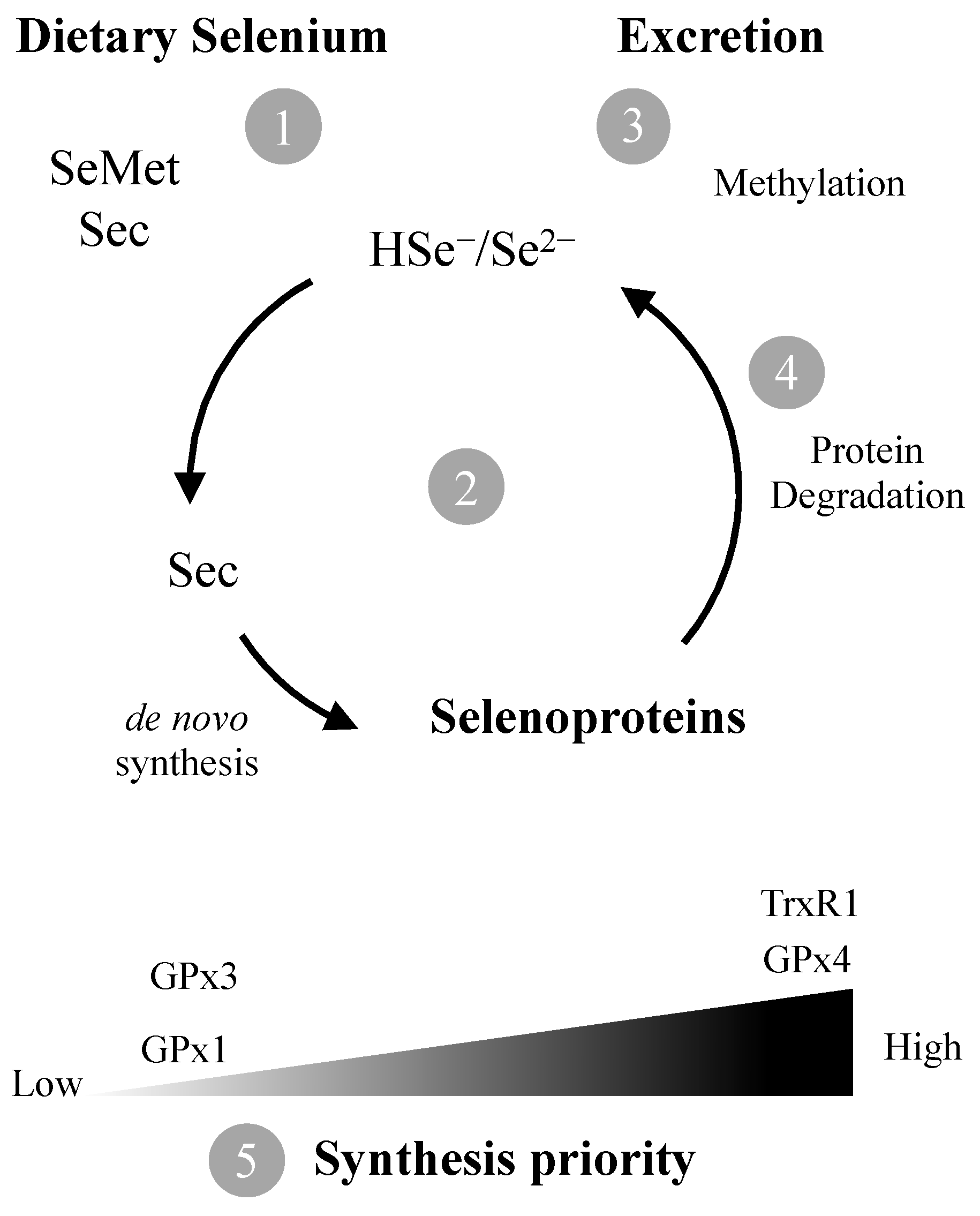
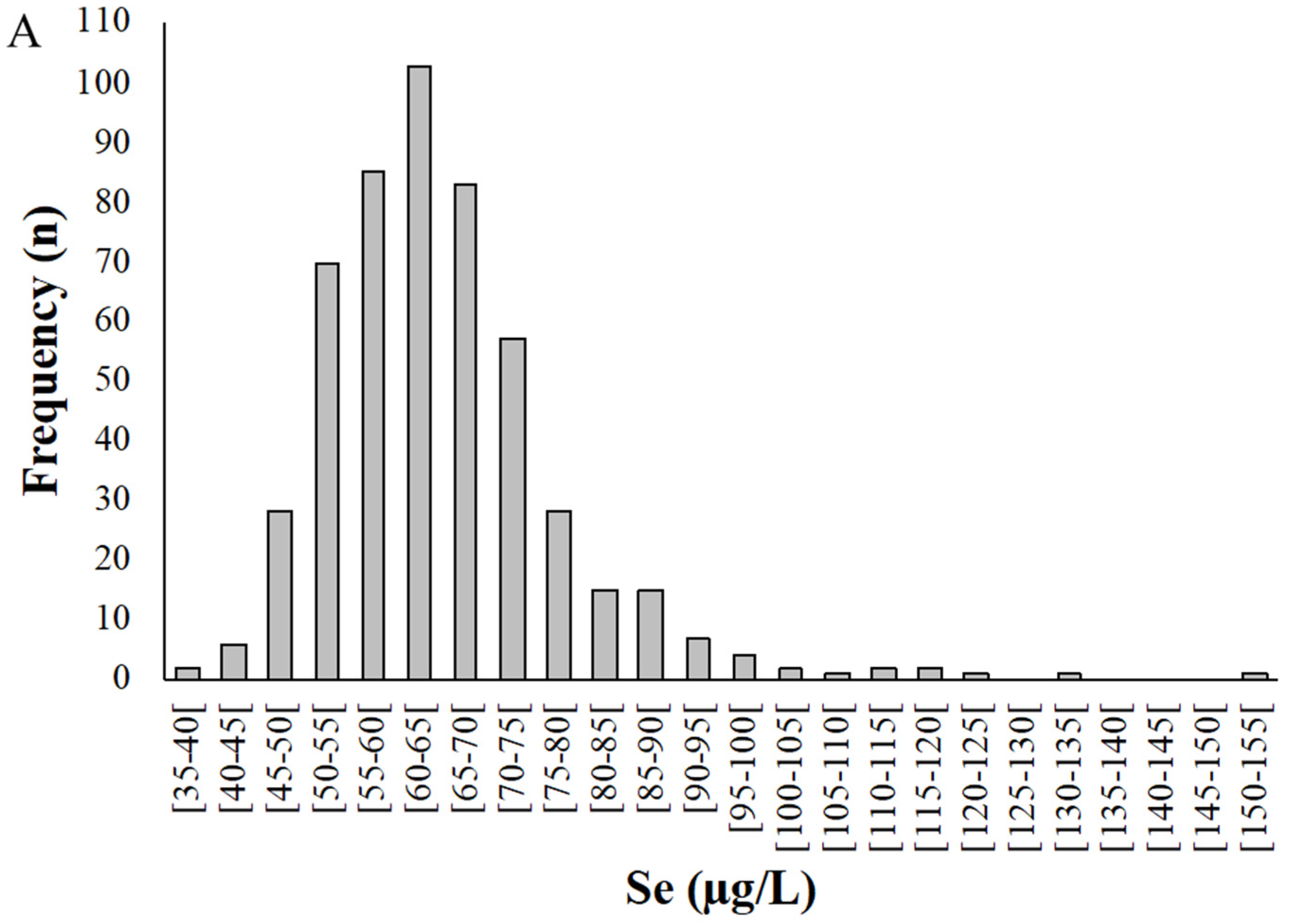

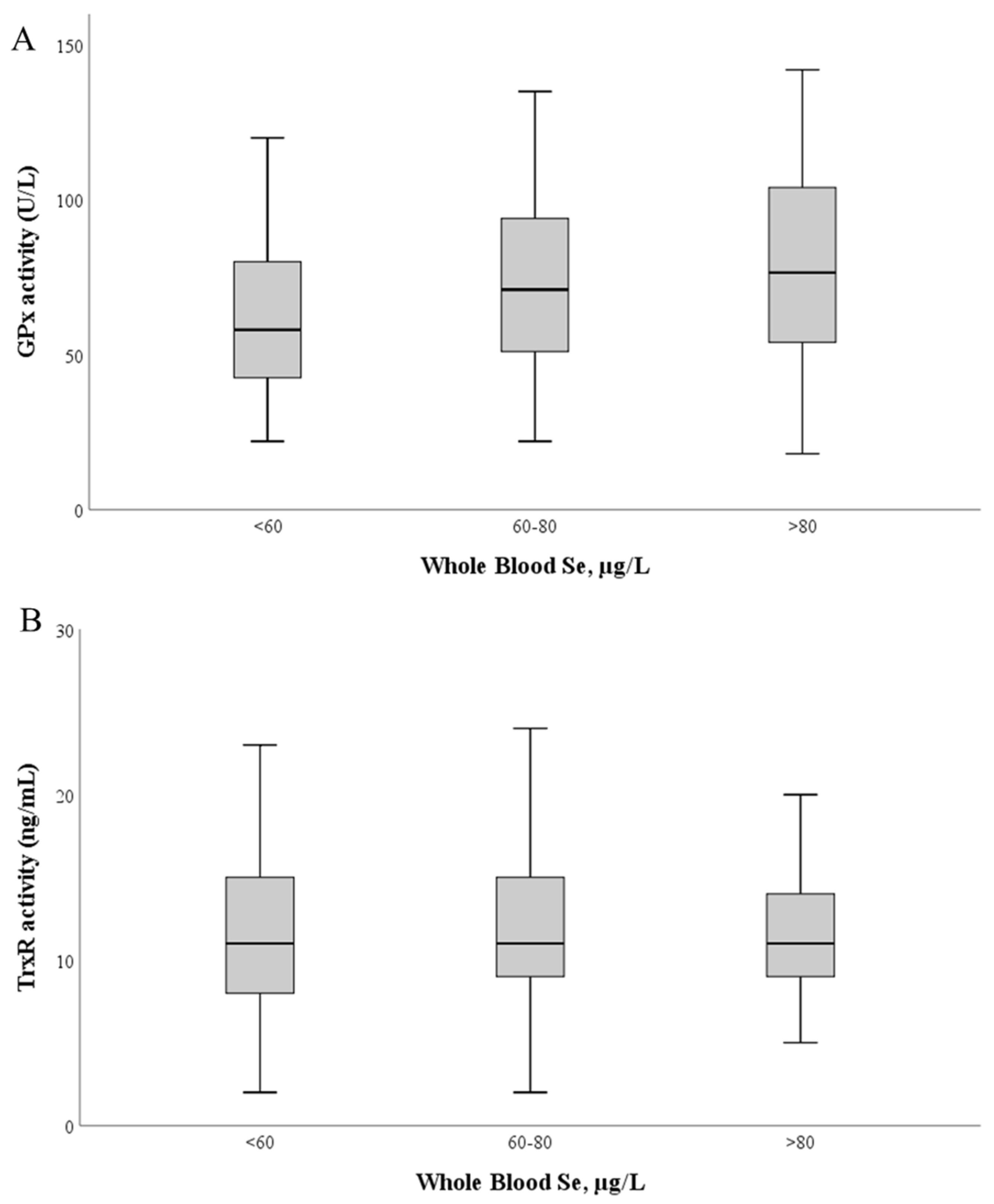
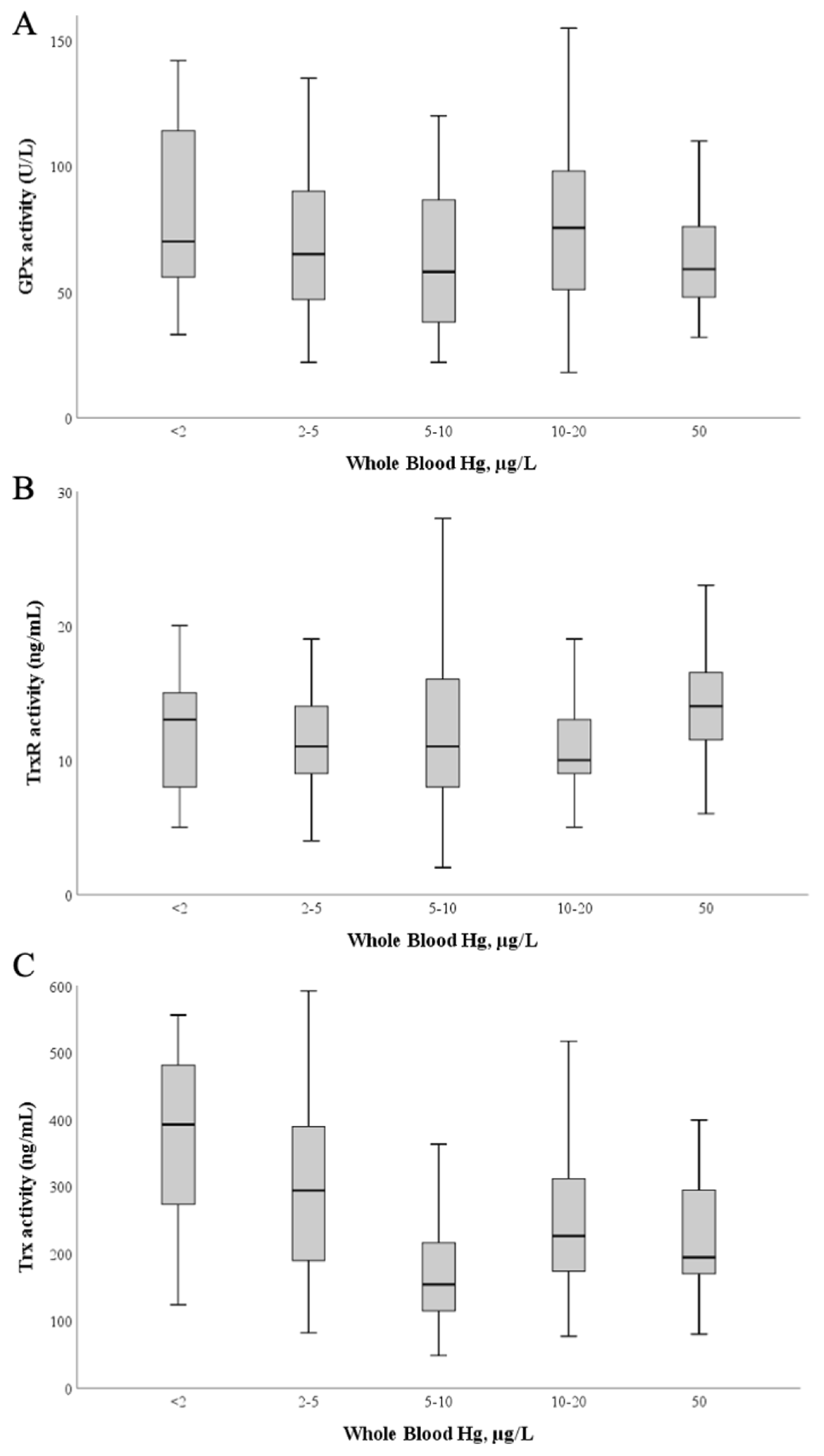
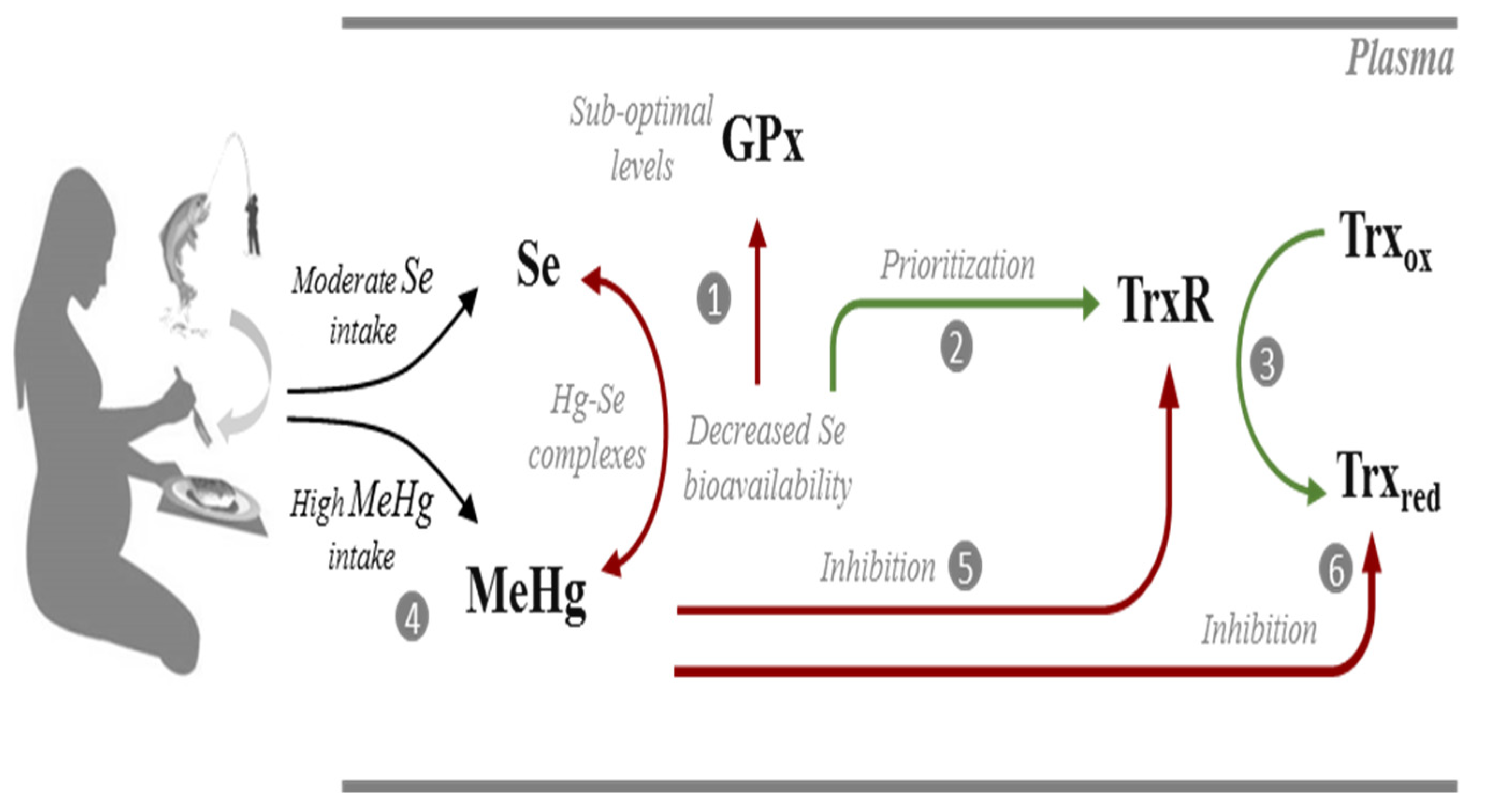
| Age (years) | 29 ± 6 | |
| Gestational weight (Kg) | 67 ± 12 | |
| Height (cm) | 165 ± 70 | |
| Week of Gestation ** | 20 ± 10 | |
| Seafood eating habits (N) | Yes | 428 |
| No | 34 | |
| DK/DA | 12 |
| Gender (N) | Selenium (µg/L) | Location | Reference | ||
|---|---|---|---|---|---|
| Male | Female | Male | Female | ||
| - | 513 167 | - | 65.0 ± 13.1 WB 46.1± 11.1 P | Madeira | Present study |
| 14 | 13 | 101 ± 1 P | 103 ± 7 P | Not specified | [52] |
| 136 | 47 | 88 ± 15 P | 81 ± 14 P | Lisbon (urban) | [53] |
| 48 | 50 | 98 ± 16 P | 81 ± 14 P | Azores, Ponta Delgada (urban) | [54] |
| 26 | 49 | 110 ± 25 P | 90 ± 21 P | Azores, Rabo de Peixe (fishing) | |
| 28 | 44 | 84 ± 22 P | 78 ± 18 P | Azores, Rabo de Peixe (rural) | |
| 28 | 71 | 90 ± 20 P | 82 ± 17 P | Azores, Água Retorta (rural) | |
| 26 | 63 | 108 ± 16 P | 96 ± 23 P | Ribeira Quente (fishing) | |
| 62 | 39 | 99.0 ± 20.5 P | 94.4 ± 16.7 P | Lisbon (urban) | [55] |
| 48 | 50 | 97.9 ± 16.2 P | 88.1 ± 14.5 P | Azores (urban) | |
| 16 | 19 | 84.5 ± 16.5 P | 84.2 ± 14.4 P | Salvaterra de Magos (rural) | |
| Women (N) | Selenium (µg/L) | Reference | ||||||
|---|---|---|---|---|---|---|---|---|
| Trimester | Not Pregnant | Trimester | Not Pregnant | |||||
| 1 | 2 | 3 | 1 | 2 | 3 | |||
| 171 * | 81 * | 84 * | - | 65.0 ± 11.2 * | 65.3 ± 13.1 * | 63.0 ± 9.1 * | - | This study |
| 48 | 48 | 50 | 74 | 64.2 ± 16.9 P | 66.6 ± 17.1 P | 61.6 ± 15.0 P | 70.7 | [60] |
| 34 | 44 | 52 | 30 | 107 ± 16.0 P | 83.0 ± 17.4 P | 79.8 ± 19.0 P | 109 ± 14.2 P | [61] |
| 49 | 38 | 30 | 22 | 75.8 ± 16.7 WB | 65.6 ± 14.0 WB | 55.2 ± 12.5 WB | 95 ± 9.3 | [62] |
Publisher’s Note: MDPI stays neutral with regard to jurisdictional claims in published maps and institutional affiliations. |
© 2022 by the authors. Licensee MDPI, Basel, Switzerland. This article is an open access article distributed under the terms and conditions of the Creative Commons Attribution (CC BY) license (https://creativecommons.org/licenses/by/4.0/).
Share and Cite
Branco, V.; Carvalho, L.; Barboza, C.; Mendes, E.; Cavaco, A.; Carvalho, C. Selenium and Redox Enzyme Activity in Pregnant Women Exposed to Methylmercury. Antioxidants 2022, 11, 2291. https://doi.org/10.3390/antiox11112291
Branco V, Carvalho L, Barboza C, Mendes E, Cavaco A, Carvalho C. Selenium and Redox Enzyme Activity in Pregnant Women Exposed to Methylmercury. Antioxidants. 2022; 11(11):2291. https://doi.org/10.3390/antiox11112291
Chicago/Turabian StyleBranco, Vasco, Luís Carvalho, Cássia Barboza, Eduarda Mendes, Afonso Cavaco, and Cristina Carvalho. 2022. "Selenium and Redox Enzyme Activity in Pregnant Women Exposed to Methylmercury" Antioxidants 11, no. 11: 2291. https://doi.org/10.3390/antiox11112291
APA StyleBranco, V., Carvalho, L., Barboza, C., Mendes, E., Cavaco, A., & Carvalho, C. (2022). Selenium and Redox Enzyme Activity in Pregnant Women Exposed to Methylmercury. Antioxidants, 11(11), 2291. https://doi.org/10.3390/antiox11112291









